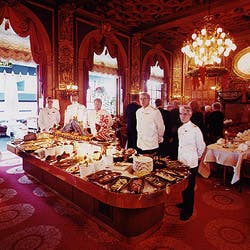
Swedish Smorgasbord Style
The Swedish smorgasbord is not the free-for-all, budget-priced buffet that Americans tend to envision when they hear the word.
The Swedish smorgasbord (literally, "bread-and-butter table") is not the free-for-all, budget-priced buffet that Americans tend to envision when they hear the word. Instead, it's an elegant spread of cold and hot foods inspired by tradition and treated with respect. This is especially true of the holiday version—the julbord, or Christmas table, around which families and groups of office colleagues gather to eat well, drink well, and sing.
The smorgasbord seems to have had its origins in the 18th century, when the Russian habit of nibbling food while sipping vodka made its way to Sweden. There, the upper classes adopted it, replacing vodka with aquavit and Russian hors d'oeuvres with their own herring, sprats, and cheese. The table laden with these snacks was at first called the brannvinsbord, or aquavit table. Over time, more foods were introduced and the name changed to emphasize eating.
A traditional smorgasbord has five parts, to be visited in order—requiring five trips to the table. The first part offers a variety of herring (including, at Christmas, sillsallad—beet and herring salad), sharp cheese, and boiled potatoes. The second is dedicated to cold fish and shellfish dishes like poached and smoked salmon, gravlax, smoked eel, and shrimp and cucumber salad. The third offers meat dishes at room temperature: cold cuts, pates, roasted reindeer, little sausages. Next are warm foods such as Jansson's temptation, herring gratin, meatballs, and, at Christmastime, ham, lutfisk, and creamed kale. The last trip to the smorgasbord is for desserts such as cakes, puddings, more cheese, and fresh fruit.
Keep Reading
Continue to Next Story










